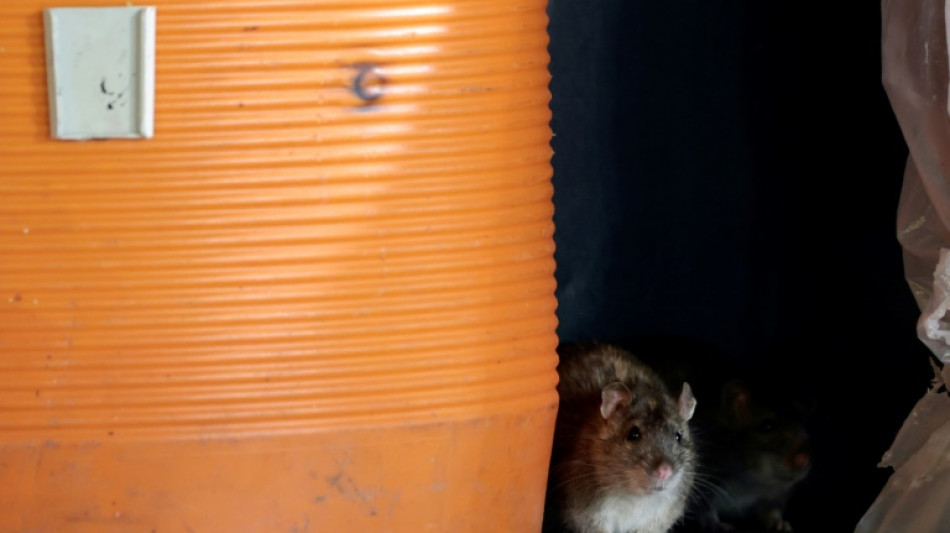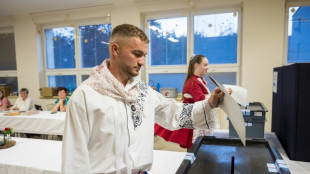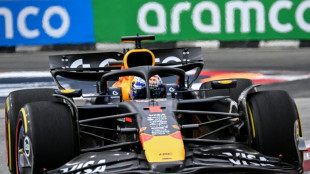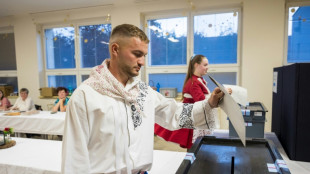
-
 US envoys head to Mideast as Trump warns Hamas against peace deal delay
US envoys head to Mideast as Trump warns Hamas against peace deal delay
-
In-form Inter sweep past Cremonese to join Serie A leaders

-
 Kolisi hopes Rugby Championship success makes South Africa 'walk tall' again
Kolisi hopes Rugby Championship success makes South Africa 'walk tall' again
-
Ex-All Black Nonu rolls back the years again as Toulon cruise past Pau

-
 Hundreds of thousands turn out at pro-Palestinian marches in Europe
Hundreds of thousands turn out at pro-Palestinian marches in Europe
-
Vollering powers to European women's road race title

-
 Struggling McLaren hit bump in the road on Singapore streets
Struggling McLaren hit bump in the road on Singapore streets
-
'We were treated like animals', deported Gaza flotilla activists say

-
 Czech billionaire ex-PM's party tops parliamentary vote
Czech billionaire ex-PM's party tops parliamentary vote
-
Trump enovys head to Egypt as Hamas agrees to free hostages

-
 Arsenal go top of Premier League as Man Utd ease pressure on Amorim
Arsenal go top of Premier League as Man Utd ease pressure on Amorim
-
Thousands attend banned Pride march in Hungarian city Pecs

-
 Consent gives Morris and Prescott another memorable Arc weekend
Consent gives Morris and Prescott another memorable Arc weekend
-
Georgian police fire tear gas as protesters try to enter presidential palace

-
 Vollering powers to European road race title
Vollering powers to European road race title
-
Reinach and Marx star as Springboks beat Argentina to retain Rugby Championship

-
 Russell celebrates 'amazing' Singapore pole as McLarens struggle
Russell celebrates 'amazing' Singapore pole as McLarens struggle
-
Czech billionaire ex-PM's party leads in parliamentary vote

-
 South Africa edge Argentina to retain Rugby Championship
South Africa edge Argentina to retain Rugby Championship
-
'Everyone's older brother': Slipper bows out in Wallabies loss

-
 Thousands rally in Georgia election-day protest
Thousands rally in Georgia election-day protest
-
Sinner starts Shanghai defence in style as Zverev defies toe trouble

-
 Russell takes pole position for Singapore Grand Prix as McLaren struggle
Russell takes pole position for Singapore Grand Prix as McLaren struggle
-
Robertson praises All Blacks 'grit' in Australia win

-
 Government, protesters reach deal to end unrest in Pakistan's Kashmir
Government, protesters reach deal to end unrest in Pakistan's Kashmir
-
Kudus fires Spurs into second with win at Leeds

-
 Rival rallies in Madagascar after deadly Gen Z protests
Rival rallies in Madagascar after deadly Gen Z protests
-
Egypt opens one of Valley of the Kings' largest tombs to public

-
 Ethiopia hits back at 'false' Egyptian claims over mega-dam
Ethiopia hits back at 'false' Egyptian claims over mega-dam
-
Sinner breezes past Altmaier to launch Shanghai title defence

-
 Czech ex-PM set to win vote, putting Ukraine aid in doubt
Czech ex-PM set to win vote, putting Ukraine aid in doubt
-
All Blacks down Wallabies to stay in Rugby Championship title hunt

-
 Gazans hail Trump ceasefire call as Hamas agrees to free hostages
Gazans hail Trump ceasefire call as Hamas agrees to free hostages
-
Zverev echoes Federer over tournaments 'favouring Sinner, Alcaraz'

-
 Yamal injury complicated, return date uncertain: Barca coach Flick
Yamal injury complicated, return date uncertain: Barca coach Flick
-
Conservative Takaichi set to be Japan's first woman PM

-
 Marsh ton powers Australia to T20 series win over New Zealand
Marsh ton powers Australia to T20 series win over New Zealand
-
Verstappen lays down marker in final Singapore practice

-
 French air traffic controllers cancel three-day strike
French air traffic controllers cancel three-day strike
-
'A bit unusual': Russia's Sochi grapples with Ukrainian drones

-
 Test skipper Gill replaces Rohit as India ODI captain
Test skipper Gill replaces Rohit as India ODI captain
-
Israel troops still operating in Gaza after Trump, hostage family appeals

-
 Jadeja stars as India crush West Indies in first Test
Jadeja stars as India crush West Indies in first Test
-
Pogacar eyes 'explosive' Euros race with Vingegaard, Evenepoel

-
 Minnie Hauk, Graffard, Japan vie for Prix de l'Arc de Triomphe glory
Minnie Hauk, Graffard, Japan vie for Prix de l'Arc de Triomphe glory
-
Three Japanese tales of Arc heartbreak

-
 Anisimova thrashes Gauff in 58 minutes to make China Open final
Anisimova thrashes Gauff in 58 minutes to make China Open final
-
Flights resume at Munich airport after second drone scare

-
 Hostage families urge immediate end to Gaza war
Hostage families urge immediate end to Gaza war
-
Czech ex-PM who wants to halt Ukraine aid set to win vote


Forget mammoths, study shows how to resurrect Christmas Island rats
Ever since the movie Jurassic Park, the idea of bringing extinct animals back to life has captured the public's imagination -- but what might scientists turn their attention towards first?
Instead of focusing on iconic species like the woolly mammoth or the Tasmanian tiger, a team of paleogeneticists have studied how, using gene editing, they could resurrect the humble Christmas Island rat, which died out around 120 years ago.
Though they did not follow through and create a living specimen, they say their paper, published in Current Biology on Wednesday, demonstrates just how close scientists working on de-extinction projects could actually get using current technology.
"I am not doing de-extinction, but I think it's a really interesting idea, and technically it's really exciting," senior author Tom Gilbert, an evolutionary geneticist at the University of Copenhagen, told AFP.
There are three pathways to bringing back extinct animals: back-breeding related species to achieve lost traits; cloning, which was used to create Dolly the sheep in 1996; and finally genetic editing, which Gilbert and colleagues looked at.
The idea is to take surviving DNA of an extinct species, and compare it to the genome of a closely-related modern species, then use techniques like CRISPR to edit the modern species' genome in the places where it differs.
The edited cells could then be used to create an embryo implanted in a surrogate host.
Gilbert said old DNA was like a book that has gone through a shredder, while the genome of a modern species is like an intact "reference book" that can be used to piece together the fragments of its degraded counterpart.
His interest in Christmas Island rats was piqued when a colleague studied their skins to look for evidence of pathogens that caused their extinction around 1900.
It's thought that black rats brought on European ships wiped out the native species, described in an 1887 entry of the Proceedings of the Zoological Society of London as a "fine new Rat," large in size with a long yellow-tipped tail and small rounded ears.
- Key functions lost -
The team used brown rats, commonly used in lab experiments, as the modern reference species, and found they could reconstruct 95 percent of the Christmas Island rat genome.
That may sound like a big success, but the five percent they couldn't recover was from regions of the genome that controlled smell and immunity, meaning that the recovered rat might look the same but would lack key functionality.
"The take home is, even if we have basically the perfect ancient DNA situation, we've got a really good sample, we've sequenced the hell out of it, we're still lacking five percent of it," said Gilbert.
The two species diverged around 2.6 million years ago: close in evolutionary time, but not close enough to fully reconstruct the lost species' full genome.
This has important implications for de-extinction efforts, such as a project by US bioscience firm Colossal to resurrect the mammoth, which died out around 4,000 years ago.
Mammoths have roughly the same evolutionary distance from modern elephants as brown rats and Christmas Island rats.
Teams in Australia meanwhile are looking at reviving the Tasmanian tiger, or thylacine, whose last surviving member died in captivity in 1936.
Even if gene-editing were perfected, replica animals created with the technique would thus have certain critical deficiencies.
"Let's say you're bringing back a mammoth solely to have a hairy elephant in a zoo to raise money or get conservation awareness -- it doesn't really matter," he said.
But if the goal is to bring back the animal in its exact original form "that's never going to happen," he said.
Gilbert admitted that, while the science was fascinating, he had mixed feelings on de-extinction projects.
"I'm not convinced it is the best use of anyone's money," he said. "If you had to choose between bringing back something or protecting what was left, I'd put my money into protection."
J.Fankhauser--BTB




